International Brotherhood of Boilermakers Canada
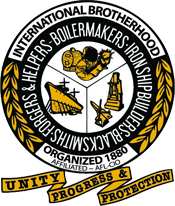
Trades
Boilermaker
Metal Fabricator
Non Destructive Testing Technicians
Welder
Today’s Boilermakers build and maintain the tanks and pressure vessels that are at the heart of huge installations, such as hydro, nuclear and other energy facilities (including oil-sands plants), chemical, cement, glass and steel plants. The pressure vessels we work on could be boilers, tanks, heat exchangers, fired heaters or reactors. They could include the lines that transmit gasses and chemicals, often under pressure, throughout a facility such as a refinery or liquid natural gas plant.
Boilermakers not only make, but move huge part assemblies into position at the installations where they work. These Boilermakers are called fitters and riggers.
Boilermakers also work in metal fabrication and are critical to the operation of fertilizer, potash and water-treatment plants, breweries and to the shipbuilding industry in Canada.
Apprenticeship
Depending on your province, you’ll spend between four and five years (4,800 to 6,000 hours) learning the trade. 720 of those hours will be spent in a community college classroom and the rest on the job.
You’ll get paid while you learn on the job. Once you graduate, you’ll be a journeyperson Boilermaker, earning top wages (up to $55 per hour) and benefits, including Canada’s best health and welfare plan and an industry-leading pension plan.
Equivalencies
Equivalencies for Boilermaker trades available (based on experience & courses) can be found here.
United Brotherhood of Carpenters
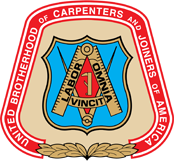
Trades
Carpenter
Floorlayer
Interior Systems Installer
Millwright
Pile driver
Members of the UBC are commercial and residential carpenters, floor layers, millwrights, pile drivers, interior systems carpenters, lathers, cabinetmakers and trade show carpenters. They build forms for concrete and frame buildings, walls, footings, columns and stairs. Carpenters also install doors, windows, storefronts and hand rails, and build cabinets, counter tops and finished stair handrails.
Apprenticeship
The UBC apprenticeship programs offer life-long careers in the construction industry. A UBC apprentice is someone who learns a trade while working under the guidance of a skilled journey level worker. Apprentices
attend 4 weeks of hands-on training per year at one of 180 training centers located throughout the country. Apprenticeship programs are available to anyone who is interested in becoming a UBC apprentice and who is
willing to apply him/herself to learning a trade.
You earn while you learn the trade. Union journeymen Carpenters wages and fringe benefits are negotiated on their behalf by the union through collective bargaining with signatory contractors. Some apprenticeship
programs partner with community colleges to offer college credit for apprenticeship classes.
Wages vary according to the geographic location of the local union. The average starting wage for 1st year apprentices is 40 - 50% of the Journeyman's wage rate plus fringe benefits. Your earnings are adjusted annually
to reflect your advancing skills and increasing knowledge of the trade.
Equivalencies
Equivalencies for Carpenters trades available (based on experience & courses) can be found here.
Millwrights

Trades
Millwright
Apprenticeship
Apprenticeship involves both classroom studies and on-the-job training under the supervision of a certified Construction Millwright/Industrial Mechanic, called a journeyperson.
As an apprentice, you earn while you learn and are paid by the hour while working on the job site. Wages start at about 60 per cent of a journeyperson’s hourly rate and increase during your apprenticeship until you
reach the full rate.
Requirements for construction millwright/industrial mechanic apprenticeship programs vary across Canada. In most provinces and territories, you must be at least 16 years old and have a Grade 12 education or equivalent
to enter the apprenticeship program. You must also have courses in math, science and English.
The salary range listed here is based on national averages and includes all experience levels, from first-year apprentices through to highly experienced journeypersons. Wages can vary depending on the contract,
company, location and collective agreements (if applicable), as well as local and national economic conditions. Overtime is not included.
What type of job will I do?
The standard work week for construction millwrights is 40 hours (8 hours a day, 5 days a week). As with many careers in construction, there are peak periods that will require you to work overtime. The number of
additional hours you work each week depends on the construction sector and region you work in, and will vary from one job to the next. If you do maintenance work, you may work in shifts. As a Construction Millwright,
you may work indoors or outdoors, often closely with other construction professionals, including electricians, steamfitter/pipefitters or welders. The job can be physically demanding – you may have to work with heavy
equipment and materials.
Info from CareersinConstruction.ca
International Brotherhood of Electricians

Trades
Electrician
Powerline Technician
The IBEW represents workers in the electrical industry including construction, gas and electric utilities, telecommunications, railroads and government agencies. Construction and residential electricians work in all
phases of the electrical construction and service industry. Their worksite ranges from single-family residences to state-of-the-art industrial plants. Inside wire workers may install and maintain conduits, switches and
converters, as well as wire lighting, to complex systems incorporating computerization and high technology. Electricians work in the electric sign industry and increasingly perform more work in the installation of
fiber optics and voice/data/video equipment. IBEW electricians participate in a five-year apprentice program.
There are four specialty areas where you will find electrical workers. These four areas are best described by the type of work done in each of those areas.
Outside Linemen are the electrical workers who install the distribution and transmission lines that move power from power plant to a factory, a business, or your home.
Inside Wiremen are electrical workers who install the power, lighting, controls and other electrical equipment in commercial and industrial buildings.
VDV Installer Technicians are electrical workers who install circuits and equipment for telephones, computer networks, video distribution systems, security and access control systems and other low voltage systems.
Residential Wiremen are electrical workers who specialize in installing all of the electrical systems in single-family and multi-family houses or dwellings.
Apprenticeship
Each of the four types of electrical work (inside Wireman, Outside Lineman, Installer Technician and Residential Wireman) share common skills and knowledge. Each also has other skills and knowledge, which are specific
to that particular area of work. Because of these differences, each type of work has a different apprenticeship program associated with it. Apprentices receive their training through the National Joint Apprenticeship
and Training Committee of NECA (National Electrical Contractors Association) and IBEW. It's a model education partnership which produces the best-trained, most up-to-date electrical apprentices and journeymen in the
country. In addition to receiving skill training on the job, apprentices are provided trade related classroom training that produces competency and pride which lead to true craftsmanship. Quite often some local
training committees provide special classes with hands-on training to support classroom lectures and discussions.
You earn while you learn the trade. Union journeymen Electrical Workers wages and fringe benefits are negotiated on their behalf by the union through collective bargaining with signatory contractors. Some
apprenticeship programs partner with community colleges to offer college credit for apprenticeship classes.
Wages vary according to the geographic location of the local union. The average starting wage for 1st year apprentices is 40 - 50% of the Journeyman's wage rate plus fringe benefits. Your earnings are adjusted annually
to reflect your advancing skills and increasing knowledge of the trade.
What type of job will I do?
Electricians can specialize as a Lineman, an Inside Wireman, an Installer/Technician, or a Residential Wireman. Journeymen Linemen erect and maintain power lines, climb power poles, and work on communication lines. It's highly skilled work that requires a great deal of concentration, skill and knowledge. Demand for this type of work will never go "out of style"... as long as folks use electricity. Joumeymen Wireman wire the industrial plants and factories, the warehouses, the office buildings, the shopping centers small and large... when something goes wrong with the electrical system in such facilities, journeyman wiremen are the ones who are called. Residential Wiremen are responsible for the repair and upgrade work in residential structures. With 90 million single family homes in the U.S., demand just for the repair/upgrade work will never cease. What's more, as more and more people buy computers, and buy items with electronic components that are sensitive to electric power quality, there's more need for the Residential Wireman's skills. Telecommunications -installer Technician are responsible for the wiring that makes the Internet and e-commerce possible. Communication industries rely on something installed everyday by our industry: wires and cables. When building owners and tenants have network wiring problems, they need a professional telecom installer/technician and he or she becomes the most important person in the building!
International Union of Elevator Constructors
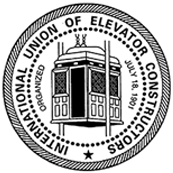
Trades
Elevator Constructor
Elevator constructors assemble, install, maintain and repair freight and passenger elevators, escalators, moving walkways and related equipment.
These tradespeople typically:
assemble elevator cars and connect car frames to counterweights
install and wire electrical and electronic control systems
install, test and adjust safety devices
troubleshoot systems and repair or replace worn parts
perform preventative maintenance
Elevator constructors and mechanics work on residential, commercial and industrial construction projects.
Apprenticeship
The term of apprenticeship for an elevator constructor is 4 years (four 12-month periods) including a minimum of 1800 hours of on-the-job training each year. Technical training provided by the Canadian Elevator Industry Educational Program (CEIEP) is the only training presently recognized.
Equivalencies
Equivalencies for Elevator Constructor are not listed on military equivalency sites.
International Union of Operating Engineers

Trades
Heavy Equipment Mechanic
Heavy Equipment Operators
Mobile Crane Operator
Tower Crane Operator
Operating Engineers build, maintain, and service places where we live, work, worship, study and play. Operating Engineers maintain control centers, boiler rooms, and HVAC units for our safety, comfort, and well-being, and their skills are put to the task every day.
Apprenticeship
You earn while you learn the trade. Union journeymen Operating Engineers wages and fringe benefits are negotiated on their behalf by the union through collective bargaining with signatory contractors. Some
apprenticeship programs partner with community colleges to offer college credit for apprenticeship classes.
Wages vary according to the geographic location of the local union. The average starting wage for 1st year apprentices is 40 - 50% of the Journeyman's wage rate plus fringe benefits. Your earnings are adjusted annually
to reflect your advancing skills and increasing knowledge of the trade.
Equivalencies
Equivalencies for Operating Engineer trades available (based on experience & courses) can be found here.
International Association of Heat and Frost Insulators and Allied Workers

Trades
Heat and Frost Insulator
Heat and frost insulators apply insulation materials to plumbing, air-handling, heating, cooling and refrigeration systems, piping equipment and pressure vessels, and walls, floors and ceilings of buildings and other structures to prevent or reduce the passage of heat, cold, sound or fire.
Heat and frost insulators’ duties may include the following:
reading and interpreting specifications and selecting appropriate insulation
measuring, cutting, applying and securing insulating material
installing vapour barriers applying waterproofing cement over insulating materials
removing insulation from buildings
Heat and frost insulators work mainly in industrial, commercial and institutional construction.
Apprenticeship
Apprenticeship training programs for heat and frost insulators vary across Canada, but generally involve four 12-month periods, including at least 5,650 hours of on-the-job training, three eight-week blocks of
technical training and a final certificate exam.
Related work experience or completion of a heat and frost insulator program at a college or technical institute can reduce the time required to complete your apprenticeship.
Equivalencies
Equivalencies for Insulators trades available (based on experience & courses) can be found here.
International Association of Bridge, Structural, Ornamental and Reinforcing Iron Workers

Trades
Ornamental Ironworker
Rebar Installer
Rigger
Steel Erector
Steel Plate Fabricator
Welder
Members of the Ironworkers assemble and erect steel framework and other metal parts in buildings and on bridges, dams, skyscrapers, factories and other steel structures. They raise, place and join steel girders and columns to form structural frameworks, including the welding for metal decking.
Apprenticeship
You earn while you learn the trade. Union journeymen Ironworkers wages and fringe benefits are negotiated on their behalf by the union through collective bargaining with signatory contractors. Some apprenticeship programs partner with community colleges to offer college credit for apprenticeship classes. Wages vary according to the geographic location of the local union. The average starting wage for 1st year apprentices is 40 - 50% of the Journeyman's wage rate plus fringe benefits. Your earnings are adjusted annually to reflect your advancing skills and increasing knowledge of the trade.
Equivalencies
Equivalencies for Ironworker trades available (based on experience & courses) can be found here.
Laborers' International Union of North America (LiUNA!)

Trades
Blaster
Cement Finisher
Construction Craft Worker
Demolition Worker
Finisher
Form Setter
Labourer
Mason Tender
Pipelayer
LIUNA represents members working in construction, environmental remediation, maintenance, food service, health care, clerical and other occupations, as well as in state, local and municipal government jobs and as mail handlers in the U.S. Postal Service. LIUNA members have helped lay down new highways, build spectacular bridges, dig tunnels and subways, build new plants, factories, dams and power plants, and erect new schools, churches, hospitals and houses. In building construction and housing, Laborers' work includes excavation, footing and foundations, carpenter tending, compaction, concrete placement, power and hand tools, general clean-up and mason tending for bricklayers. Environmental laborers do asbestos removal, hazardous waste and radiation clean-up. The work performed by Laborers is very physical and it includes digging, carrying, pulling and bending--usually outside in all kinds of weather for long hours at a time.
Apprenticeship
Formal apprenticeship programs provide thorough preparation for jobs as Construction Craft Laborers (CCL). There are over 80 CCL apprenticeship programs in the United States operated under guidelines established by the
LIUNA Training and Education Fund. Programs include at least 4,000 hours of on-the-job training, with 144 hours of classroom training. Apprentices learn the skills necessary to work on buildings, highways and heavy
construction sites; tunnel and shaft excavations; demolition and environmental remediation sites and must master the skills before they complete the program. Entry requirements vary from state to state, but all
apprenticeship programs require the individual to be 18 years old (see School-to-Career below for exceptions), must be able to read, write, comprehend, and understand the classroom material, and be physically able to
do the work of the trade. Most CCL apprenticeship programs require drug testing after acceptance into the program and prior to working in the field.
You earn while you learn the trade. Union journeymen Laborers wages and fringe benefits are negotiated on their behalf by the union through collective bargaining with signatory contractors. Some apprenticeship programs
partner with community colleges to offer college credit for apprenticeship classes.
Wages vary according to the geographic location of the local union. The average starting wage for 1st year apprentices is 40 - 50% of the Journeyman's wage rate plus fringe benefits. Your earnings are adjusted annually
to reflect your advancing skills and increasing knowledge of the trade.
What type of job will I do?
Construction Craft Laborers (CCL's) are skilled workers who provide much of the physically demanding labour at construction projects, tunnel and shaft excavations, environmental remediation projects, and demolition sites. They clean and prepare sites, dig trenches, mix and place concrete, and set braces to support the sides of excavations. At environmental remediation projects, they perform material and atmospheric sampling; build, clean, and decontaminate enclosure structures; remove, package, and transport hazardous materials. Other highly specialized tasks include operating laser guidance equipment to place pipes, and setting explosives for tunnel, shaft, and road construction. In addition to these duties, construction craft laborers may assist other craft workers. Construction craft laborers operate a variety of equipment including pavement breakers; jackhammers; earth tampers; concrete, mortar, and plaster mixers; guided boring machines; small mechanical hoists; laser beam equipment; surveying and measuring equipment; and monitoring and sampling equipment.
International Union of Bricklayers and Allied Craftworkers
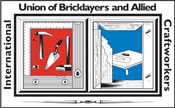
Trades
Brick Mason
Cement Finisher
Cement Mason
Finisher
Marble Mason
Marble, Mosaic and Terrazzo Worker
Plasterer
Pointer-Cleaner-Caulkers
Stone Mason
Tile Setter
BAC represents an array of skilled workers who practice the crafts of bricklaying, plastering, tile setting, stone, marble and cement masonry and terrazzo and mosaic work. These craftsmen also conduct pointing/cleaning/caulking, restoration and refractory work.
Apprenticeship
The International Union of Bricklayers and Allied Craft workers' apprenticeship and training system is widely recognized for producing highly skilled craft workers. Through Local union programs and those offered
through the International Masonry Institute, BAC members and contractors have access to training opportunities unmatched in the masonry industry.
These training programs are jointly funded by labour and management through collectively bargained contributions. These contributions are evidence of BAC's and its signatory contractors' commitment to develop highly
skilled masonry craft workers.
You earn while you learn the trade. Union journeymen bricklayers earn wages and fringe benefits that are negotiated on their behalf by the union through collective bargaining with signatory contractors. Some
apprenticeship programs partner with community colleges to offer college credit for apprenticeship classes.
Wages vary according to the geographic location of the local union. The average starting wage for 1st year apprentices is 40 - 50% of the Journeyman's wage rate plus fringe benefits. Your earnings are adjusted annually
to reflect your advancing skills and increasing knowledge of the trade.
What type of job will I do?
BAC craft workers build, repair and renovate structures, and portions of structures that are made of brick and other clay products, structural tile, concrete, cement, stone, marble, glassblock, terra cotta, tile, terrazzo, plaster, mosaics, castables and artificial masonry units made of any material. Their work includes laying and setting installation or application of all such materials and the preparation of all structures or components to receive such materials. The skilled crafts represented by the BAC, often called the trowel trades, are Bricklaying and Block Laying, Concrete Masonry, Plastering, Pointing, Caulking and Restoration, Refractory and Industrial Masonry, Stone and Marble Masonry, Terrazzo Work, Tile Laying and Mosaic Work.
International Union of Painters and Allied Trades
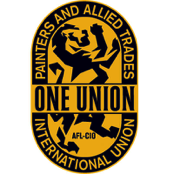
Trades
Drywall Finisher
Glazier
Painter and Decorator
The International Union of Painters and Allied Trades (IUPAT) represents a growing force of over 140,000 working men and women in the United States and Canada. IUPAT's members work in the finishing trades as painters, drywall finishers, wallcoverers, glaziers, glass workers, floor covering installers, sign makers, display workers, convention and show decorators, and in many more exciting occupations. Tradesmen's skills are in high demand at every construction project in North America. The IUPAT membership extends beyond far beyond the workplace, however. Recognized as one of the most active unions in the labour movement, IUPAT members help shape their communities in many ways: through an abiding commitment to service, by fighting passionately for workers' rights that benefit all working families, and through effective and aggressive political mobilization.
What do Painters do?
- Painters remove and apply protective and decorative coatings to homes, office buildings, bridges, factories, ships and other structures.
- Drywall Finishers apply multiple coats to sheet rock to prepare it to be painted or have other decorative finishes or materials applied.
- Glaziers (Architectural metal and glass workers) fabricate and install aluminum and glass storefronts, doors, windows, and curtain systems and other related products.
- Floor and Decorative Covering Workers install all resilient, carpet and floor systems either as a decorative covering or topping in residential, commercial or industrial settings.
- Sign and Display Workers make signs which are designed for advertising - both standard billboards and more complex, lighted billboards. They also set up and dismantle the display booths which are used to provide information at trade shows.
Apprenticeship
All apprenticeship programs incorporate skills training with safety and health training. Apprentices are taught about the International Union of Painters and Allied Crafts (IUPAT) and how the union operates. All
apprentices are paid and receive regular raises during the course of their apprenticeship. Sign and Display workers have a two-year apprenticeship, Painters, Drywall Finishers and Floor Coverers participate in a
three-year apprenticeship, and Glaziers have a four year apprenticeship.
You earn while you learn the trade. Union journeymen Painters wages and fringe benefits are negotiated on their behalf by the union through collective bargaining with signatory contractors. Some apprenticeship programs
partner with community colleges to offer college credit for apprenticeship classes.
Wages vary according to the geographic location of the local union. The average starting wage for 1st year apprentices is 40 - 50% of the Journeyman's wage rate plus fringe benefits. Your earnings are adjusted annually
to reflect your advancing skills and increasing knowledge of the trade.
What type of job will I do?
IUPAT members work in one or more of several crafts: painting, wallpaper hanging, glazing (glass work), drywall and taping, floor covering, and sign and display work. Painters and paperhangers work in industrial, commercial and residential settings, from bridges and ships to interior walls of office buildings and homes. Drywall finishers tape, fill in and smooth seams in sheets of drywall. Glaziers prepare and install various kinds of glass, mirrors, metal framing and doors/entrances to buildings. Floor coverers work with resilient floors, as well as carpet and decorative coverings. Exterior sign and display work, like billboards, is another choice. Other types of work are convention display and show decorators.
Operative Plasterers' and Cement Masons' International Association of the United States and Canada

Trades
Cement Mason
Fireproofer
Restoration Steeplejack
OP & CMIA members represent skilled plasterers, cement masons, shop hands and associated members. Plasterers finish interior walls and ceilings of buildings; apply plaster on masonry, metal, and wire lath or gypsum. Bridges, canals, dams, reservoirs, roads and many other engineering feats would be impossible without the skills of OP & CMIA cement masons. Cement masons are responsible for all concrete construction, including pouring and finishing of slabs, steps, wall tops, curbs and gutters, sidewalks, paving and other concrete construction.
What do Operative Plasterers and Cement Masons Do?
Plasterers’ Work includes these valuable skills:
- All Types of Plastering
- Exterior Insulated Finish System (EIFS) Application – including the installation of the insulation board whether adhesive-applied or fastened with mechanical fasteners.
- Restoration Work
- Acoustical Tile Application
- Artificial Marble Work
- Fireproofing Application
- Epoxy Coating Application
- Sculpturing
- Swimming Pool Interior Application
- Wallboard Taper and Joiner/Drywall Application/ Level 5 Drywall Skim coating
- Modern Veneer and Hardcoat Applications
- Cornice and Ornamental Plastering
- Building Illusions and Props for the Motion Picture Industry
- and more!
- Concrete Finishing on Buildings, Highways, Sidewalks, Curbs and Gutters
- Concrete Saw and Scoring Machine Operation
- Floor Hardeners, Sealers and Curing Applications
- Gunite Operation
- Laser Screed Operation
- Installing Seamless Flooring (Epoxy)
- Sand Blasting and Bush Hammering
- Restoration Work (Concrete Repair)
- Waterproofing
- Form Setting
- Grouting
- Epoxy Coatings Application
- Decorative Concrete: Stenciled, Stamped, Stained
- and more!
Apprenticeship
As part of its long-standing tradition of pursuit of excellence, the OPCMIA, in the post-war era, began to establish apprenticeship to assure a constant supply of highly skilled craftsmen. Just as the OPCMIA advocated
use of quality materials, it also demanded quality Plasterers and Cement Finishers who were properly trained in the craft. In 1946 the union joined with the Contracting Plasterers' International Association and the
Associated General Contractors to establish the National Apprentice Training Standards. Through this program the union was able to guarantee a steady flow of qualified Plasterers and Cement Finishers to an
ever-expanding construction industry. Working closely with the Veterans' Administration, the union indentured a large number of returning servicemen into apprenticeship programs..
OPCMIA Apprentices receive a minimum of 144 hours of classroom training, plus hands-on and/or on-the-job training.
What type of job will I do?
You earn while you learn the trade. Union journeymen Operative Plasterers and Cement Masons wages and fringe benefits are negotiated on their behalf by the union through collective bargaining with signatory
contractors. Some apprenticeship programs partner with community colleges to offer college credit for apprenticeship classes.
Wages vary according to the geographical location of the local union. Wages are determined as a percentage of the journeyperson’s wage and increase throughout the apprenticeship program as your knowledge and skills
increase.
United Association of Journeymen and Apprentices of the Plumbing and Pipe Fitting Industry of the United States and Canada

Trades
Gasfitter
Instrumentation Technician
Non Destructive Testing Technicians
Pipeliner
Plasterer
Plumber
Production Shop Employees
QCC Technician
Refrigeration and Air Conditioning Mechanic
Sprinkler System Installers
Steamfitter / Pipefitter
Welder
UA is a multi-craft union that represents plumbers and pipe, sprinkler, and refrigeration fitters, as well as service technicians. All of these jobs require the installation, remodeling or maintenance of systems that carry water, steam, air and other liquids or gases necessary for sanitation, industrial production, heating and air conditioning, and many other uses. Workers measure, cut, and bend pipe, as well as weld, braze, caulk, solder, glue or thread joints at residential and commercial job sites.
What do Plumbers and Pipe Fitters Do?
- Install, Remodel, and Maintain Various Sanitation and Heating and Air Conditioning Systems
- Measure, Cut, and Bend Pipe
- Weld, Braze, Caulk, Solder, Glue or Thread Joints at Residential and Commercial Job Sites
Apprenticeship
To join the UA without any prior experience, individuals enter a United Association five-year apprenticeship program and are part of a select group of men and women motivated to learn a complex and challenging trade
while upholding the ideals of trade unionism.
Applicants are evaluated on the same fair basis, without regard to race, sex, national origin or religious affiliation.
UA apprentices learn through both classroom and on-the-job training in what is considered by many to be the best construction industry apprentice program in the world. The five-year apprenticeship period is divided
into one-year segments, each of which includes 1,700 to 2,000 hours of on-the-job training and a minimum of 216 hours of related classroom instruction.
All UA apprentices receive a strong general education background in the trade, with core courses in basics such as mathematics, drawing and so on. At a certain point, apprentices can choose a specific path to follow,
to become trained as a journeyman plumber, pipe fitter, sprinkler fitter, service mechanic, and so on. Apprenticeship is not an easy time: UA apprentices must work the same hours as journeymen plus attend night
classes. Yet, this can be a highly rewarding career path for an individual who is motivated to learn the piping trade and become an active member of a proud and noble trade union.
Certification Programs
Certification is the wave of the future in the piping industry. With the increasingly complex and challenging work that must be done by the modern pipe mechanic, it is almost required that craftsmen seek some form of official validation of their skills. In addition to the considerable prestige and knowledge that comes with being a UA journeyman, UA members can also pursue these certifications in a variety of specialized areas. UA Certification Programs include valve repair, medical gas installation, welding, CFC removal, and instrumentation. Each of these programs relies on third party validation for an objective evaluation and testing of our members' skills and abilities.
-
Welder's Certification Program
The UA Welder Certification Program has no parallel in the building and construction industry. Developed and designed to help meet the growing need for experienced, quality welders.
The program provides pre-tested, certified and immediately available journeymen welders throughout the United States and Canada at no cost to the construction user. The United Association underwrites the cost of testing and qualifying its welders by independent testers, auditors and other third parties involved in the program's success.
-
Who Needs UA Certified Welders?
America's power companies are leading the way in signing on to the United Association Welder Certification Program. In construction and maintenance of critical assurance of continuing compliance with the energy industry's demanding quality and safety standards.
Breweries and other food and beverage producers; pharmaceutical, educational, medical, and correctional facilities; malls and other large commercial developments all depend on quality workmanship.
-
UA's Welder Certification Process
UA welders are tested at local training sites across the United States and Canada under a consistent set of guidelines and rules.
Applicants are tested on the welding processes most commonly used on the majority of construction projects. Welders can choose to seek certification in any or all processes.
You earn while you learn the trade. Union journeymen Plumbers and Pipefitters wages and fringe benefits are negotiated on their behalf by the union through collective bargaining with signatory contractors. Some
apprenticeship programs partner with community colleges to offer college credit for apprenticeship classes.
Wages vary according to the geographic location of the local union. The average starting wage for 1st year apprentices is 40 - 50% of the Journeyman's wage rate plus fringe benefits. Your earnings are adjusted annually
to reflect your advancing skills and increasing knowledge of the trade.
What type of job will I do?
UA members (plumbers, pipefitters, sprinklerfitters, refrigeration fitters, and service technicians) are involved in just about every aspect of construction involving piping from the space program to nuclear power houses to refineries to shipbuilding. UA craftsmen ply their skills in commercial, industrial and residential arenas. They may be found on jobsites involving single family homes, garden and high-rise apartment buildings, large and small office buildings, power plants, chemical installations and factories. At this very moment, there may also be UA members at work installing complicated medical gas piping in your local hospital or putting sprinkler systems in the hotel where you will take your family on vacation. Other UA members are laying pipelines that stretch across the landscape to serve your community's energy needs. Visitors to the 1996 Olympic venues in Atlanta, Georgia and sports enthusiasts trekking to the Pro Football Hall of Fame in Canton, Ohio all have seen firsthand just a few of the many recent projects built or expanded with the craftsmanship of UA members.
Sheet Metal Workers' International Association (SMART)

Trades
Architectural Metals and Panels
Coping and Flashing
Decking Installer
Roofer
Sheet Metal Workers
Siding Installer
SMWIA members work in several industries. Sheet metal workers fabricate, install and service heating, venting, and air conditioning systems; blowpipe and industrial systems; metal roofing; coping and flashing; and stainless steel work for restaurants, kitchens and hospitals. They prepare shop and field drawings manually and with computer programs. Members also provide HVAC/R service.
What do Sheet Metal Workers Do?
Fabricate, Install and Service:- Heating, Venting, and Air Conditioning Systems
- Blowpipe and Industrial Systems
- Metal Roofing
- Coping and Flashing
- Stainless Steel Work for Restaurants, Kitchens and Hospitals
Apprenticeship
The apprenticeship program for sheet metal workers combines on-the-job training with classroom instruction, which takes place at state-of-the art JATC owned facilities or in the vocational training departments of local
school and/or community colleges. Each JATC program has its own computers, which allows the JATC to deliver training, monitor progress, and communicate with other apprenticeship programs through the International
Training Institute (ITI) home page.
The apprenticeship program lasts four years, during which apprentices receive wages and benefits as well as top-of-the-line instruction at no cost! In the first and second year, apprentices learn about drafting, sheet
metal tools, safety procedures, pattern layout and development as well as how mathematics applies to the trade. In the third year, apprentices work more on their own, and will learn how to install HVAC equipment,
welding, hoisting and rigging, and retrofitting environmental systems. Finally, in the fourth year, apprentices learn about fine tuning HVAC systems and welding techniques. Of course, by the end of the fourth year
apprentices attain journeyperson status!
You earn while you learn the trade. Union journeymen Sheet Metal Workers' wages and fringe benefits are negotiated on their behalf by the union through collective bargaining with signatory contractors. Some
apprenticeship programs partner with community colleges to offer college credit for apprenticeship classes.
Wages vary according to the geographic location of the local union. The average starting wage for 1st year apprentices is 40 - 50% of the Journeyman's wage rate plus fringe benefits. Your earnings are adjusted annually
to reflect your advancing skills and increasing knowledge of the trade.
What type of job will I do?
Sheet metal workers perform all types of tasks using metal. They design, fabricate and install heating, ventilating, and air conditioning systems. When an air conditioning system breaks or has problems, it is the sheet metal workers who use computers to troubleshoot the problem and then perform the service work to correct it. Sheet metal workers are responsible for the stainless steel cabinets and countertops you see in restaurants and cafeterias. They also perform work on skylights, signs, metal ceilings and downspouts.
International Brotherhood of Teamsters

Trades
Inventory Control Personnel
Truck Driver
Warehouse Operations
The Teamsters union has several divisions, including a Building Material and Construction Trades Division. Members in this division are truck drivers who transport and haul material, merchandise, equipment or personnel between various locations--including construction sites, manufacturing plants, freight depots, warehouses, and wholesale and retail facilities. They may also load and unload, make minor mechanical repairs and keep trucks in good working order.
Apprenticeship
In the near future, the Teamsters National Education and Training Fund will offer regional training programs. In the meantime, we can direct you to alternative resources to earn a Commercial Drivers License (CDL). A
CDL is a requirement for obtaining a union position with a major or local freight carrier covered under the National Master Freight Agreement.
Teamster drivers are highly skilled due to a combination of education, training and experience. When it comes to education and training we recommend driver-training courses certified by the Professional Truck Driving
Institute (PTDI). PTDI certifies driver-training courses that meet training standards established and recognized by both industry and government. PTDI gives students the foundation to become quality and safe drivers.
The Teamsters have representation in the development of PTDI's training standards and on the PTDI Board of Directors.
You earn while you learn the trade. Union journeymen Teamsters wages and fringe benefits are negotiated on their behalf by the union through collective bargaining with signatory contractors.
Wages vary according to the geographic location of the local union. The average starting wage for 1st year apprentices is 40 - 50% of the Journeyman's wage rate plus fringe benefits. Your earnings are adjusted annually
to reflect your advancing skills and increasing knowledge of the trade.
What type of job will I do?
The Construction Teamster is a truck driver whose job can be quite diversified, depending on the size of the contracting firm for whom he or she is employed. Teamsters skillfully operate a variety of trucks, including flat beds, tandems, ready-mix and dumps. Construction Teamsters are an important part of a construction team because they are responsible for delivering the materials to the jobsite.
Quality Control Council of Canada

Trades
Non Destructive Testing Technician
Field Heat Treatment Technician
The Quality Control Council (QCC) is a joint venture between the International Brotherhood of Boilermakers (IBB) and the United Association of Journeymen and Apprentices of the Plumbing and Pipe Fitting Industry of the United States and Canada (UA), and is recognized as the designated Union to represent non-destructive testing and field heat treatment technicians across Canada.
The two organizations determined that these specially trained and highly skilled technicians had a unique interest and it was determined that they would be best represented independently of the affiliate union so the Quality Control Council of Canada was created. While QCC members retain the rights and privileges of both organizations, they are encouraged to participate in the activities of their home locals and lodges; in many ways, they benefit from the resources of both organizations. The QCC membership is strong, is growing rapidly with approximately 3,000 members across Canada (January 2011) and has also served to build strong relations between the UA and IBB and to benefit all of our members.
Apprenticeship
At present, there are no formal apprenticeship programs for quality control technicians. Most technicians start as trainees and receive their practical training in-house on the job. Technicians are required to take courses at designated third-party training centers to obtain their theoretical requirements for certification from the Canadian General Standards Board (CGSB). Upon successful completion of these courses, technicians are required to report to CGSB certified test centres for their written and practical tests. The QCC has opened its own training facility and has been certified by the CGSB to train in all NDT methods as well as has been certified as a written test centre.
The QCC and NDTMA jointly administer an industry training fund that reimburses all training and certification costs for member technicians. The Training Fund promotes constant education and upgrading of the QCC Members.
What type of job will I do?
Non-Destructive testing (NDT) is a very specialized type of work that plays a critical function within the Construction and Manufacturing Industries in Canada. The Industry is comprised of highly specialized technicians who use sophisticated equipment and techniques to evaluate areas that are difficult or impossible to examine using the naked eye.
Technicians inspect boilers, vessels, piping, building materials, fabrication & joining processes and evaluate the integrity of welded structures in new repairs to ensure safe, efficient operation in compliance with stringent government codes and strict industry standards.